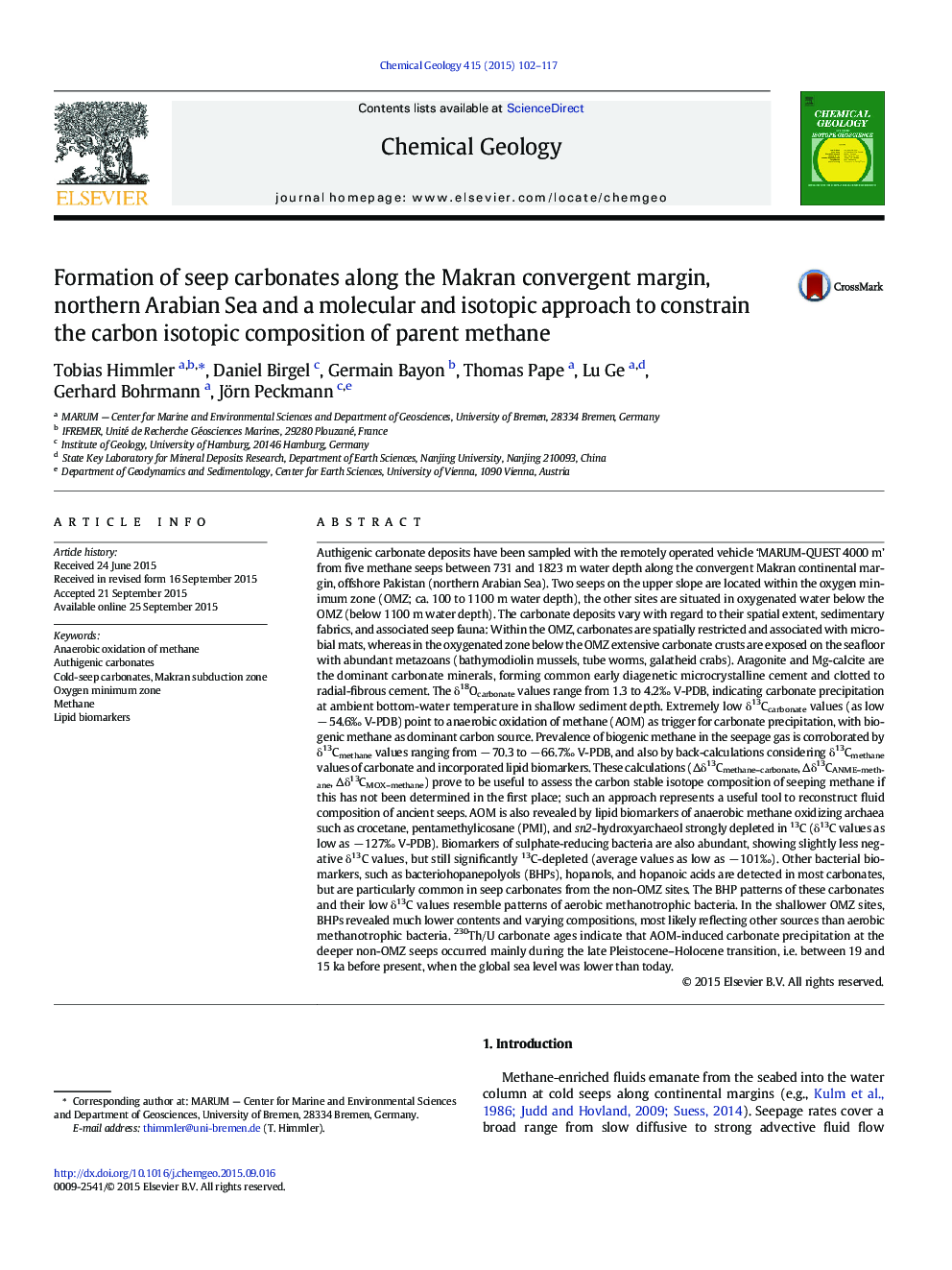| کد مقاله | کد نشریه | سال انتشار | مقاله انگلیسی | نسخه تمام متن |
|---|---|---|---|---|
| 6436227 | 1637559 | 2015 | 16 صفحه PDF | دانلود رایگان |
• Seep carbonates were sampled across an oxygen minimum zone (OMZ).
• Sedimentary fabrics of seep carbonates vary across the OMZ.
• Lipid biomarkers indicate AOM induced carbonate formation.
• Carbonates were formed mainly between 19 and 15 ka BP.
• Biomarkers of aerobic methanotrophs were preserved within carbonates.
• Carbon partitioning between methane, carbonate, and organic molecules reveals methane source.
Authigenic carbonate deposits have been sampled with the remotely operated vehicle ‘MARUM-QUEST 4000 m’ from five methane seeps between 731 and 1823 m water depth along the convergent Makran continental margin, offshore Pakistan (northern Arabian Sea). Two seeps on the upper slope are located within the oxygen minimum zone (OMZ; ca. 100 to 1100 m water depth), the other sites are situated in oxygenated water below the OMZ (below 1100 m water depth). The carbonate deposits vary with regard to their spatial extent, sedimentary fabrics, and associated seep fauna: Within the OMZ, carbonates are spatially restricted and associated with microbial mats, whereas in the oxygenated zone below the OMZ extensive carbonate crusts are exposed on the seafloor with abundant metazoans (bathymodiolin mussels, tube worms, galatheid crabs). Aragonite and Mg-calcite are the dominant carbonate minerals, forming common early diagenetic microcrystalline cement and clotted to radial-fibrous cement. The δ18Ocarbonate values range from 1.3 to 4.2‰ V-PDB, indicating carbonate precipitation at ambient bottom-water temperature in shallow sediment depth. Extremely low δ13Ccarbonate values (as low − 54.6‰ V-PDB) point to anaerobic oxidation of methane (AOM) as trigger for carbonate precipitation, with biogenic methane as dominant carbon source. Prevalence of biogenic methane in the seepage gas is corroborated by δ13Cmethane values ranging from − 70.3 to − 66.7‰ V-PDB, and also by back-calculations considering δ13Cmethane values of carbonate and incorporated lipid biomarkers. These calculations (Δδ13Cmethane–carbonate, Δδ13CANME–methane, Δδ13CMOX–methane) prove to be useful to assess the carbon stable isotope composition of seeping methane if this has not been determined in the first place; such an approach represents a useful tool to reconstruct fluid composition of ancient seeps. AOM is also revealed by lipid biomarkers of anaerobic methane oxidizing archaea such as crocetane, pentamethylicosane (PMI), and sn2-hydroxyarchaeol strongly depleted in 13C (δ13C values as low as − 127‰ V-PDB). Biomarkers of sulphate-reducing bacteria are also abundant, showing slightly less negative δ13C values, but still significantly 13C-depleted (average values as low as − 101‰). Other bacterial biomarkers, such as bacteriohopanepolyols (BHPs), hopanols, and hopanoic acids are detected in most carbonates, but are particularly common in seep carbonates from the non-OMZ sites. The BHP patterns of these carbonates and their low δ13C values resemble patterns of aerobic methanotrophic bacteria. In the shallower OMZ sites, BHPs revealed much lower contents and varying compositions, most likely reflecting other sources than aerobic methanotrophic bacteria. 230Th/U carbonate ages indicate that AOM-induced carbonate precipitation at the deeper non-OMZ seeps occurred mainly during the late Pleistocene–Holocene transition, i.e. between 19 and 15 ka before present, when the global sea level was lower than today.
Journal: Chemical Geology - Volume 415, 15 November 2015, Pages 102–117
